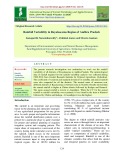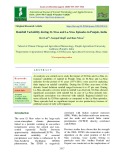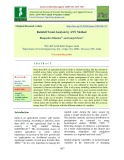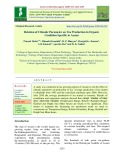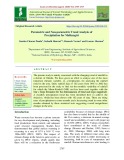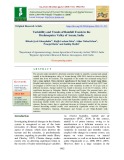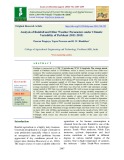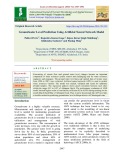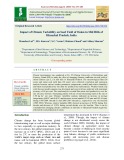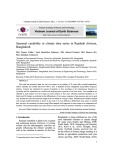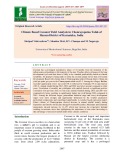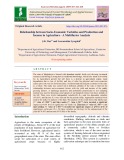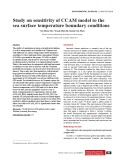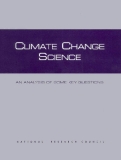
Rainfall variability analysis
-
The present research investigation was undertaken to work out the rainfall variability of all districts of Rayalaseema in Andhra Pradesh. The meteorological data of rainfall required for the rainfall variability analysis was collected during 1989-2018 from Central Research Institute for Dryland Agriculture, Hyderabad.
 8p
8p  caygaocaolon11
caygaocaolon11
 21-04-2021
21-04-2021
 10
10
 1
1
 Download
Download
-
Rainy season and its variability for crop planning in Aurad (Bidar Dist.) region of Karnataka, India
Rainfall data for the period 1957 - 2015 is used to analyze nakshatra-wise, monthly, seasonal and annual variability of rainfall. The analysis of daily rainfall data (1957-2015) indicates that the average annual rainfall for the Aurad region will be 830.5 mm. The lowest and highest recorded annual rainfall was 280.4 and 1337.7 mm respectively.
 6p
6p  cothumenhmong9
cothumenhmong9
 18-01-2021
18-01-2021
 12
12
 1
1
 Download
Download
-
An analysis was carried out to study the impact of El-Nino and La-Nina on regional variability of rainfall in Punjab. Data on El-Nino and La-Nina episodes for the period of 41 years (1971-2011) were used for analysing their impact on rainfall variability.
 8p
8p  trinhthamhodang9
trinhthamhodang9
 16-12-2020
16-12-2020
 11
11
 2
2
 Download
Download
-
The study area is a macrowatershed of river Kelo, a tributary of Mahanadi River. In this paper, the results show that as the use of number of influencing variables increases, the accuracy increases. ANN technique gives accurate results in a very short period of time which makes the feasibility of this method. The results showed that the accuracy ranges from 93 to 98 percent with the different number of variables.
 11p
11p  nguaconbaynhay7
nguaconbaynhay7
 15-08-2020
15-08-2020
 10
10
 2
2
 Download
Download
-
A study was conducted at tea growing regions of Assam to see the effect of climatic parameter on production of tea. Average production of tea started to diminish from 1992 and the trend had continued upto 2009. However, after 2010 the average production of tea started to increase. Results of correlation and regression analysis showed that except ‘number of rainy days’ other four variables (Temperature Range, Relative Humidity Range, Rainfall and Bright Sun Shine hours) are found to be significant.
 7p
7p  angicungduoc6
angicungduoc6
 22-07-2020
22-07-2020
 13
13
 1
1
 Download
Download
-
The present study is mainly concerned with the changing trend of rainfall in a district of Odisha. We have given an effort to analyse one of the most important climatic variable, i.e., precipitation, for analysing the rainfall trend in the area. Daily rainfall data of 102 years from 1901 to 2002 has been processed in the study to find out the monthly variability of rainfall for which the Mann-Kendall (MK) test has been used together with the Sen‟s Slope Estimator for the determination of trend and slope magnitude.
 11p
11p  angicungduoc6
angicungduoc6
 22-07-2020
22-07-2020
 10
10
 2
2
 Download
Download
-
The present study intended to determine potential trends in monthly, seasonal and annual rainfall in the Brahmaputra valley of Assam during 1986-2015, based on observed daily rainfall data from 10 locations. The magnitude of the trends was estimated using TheilSen’s slope method, while statistical significance of the trends was tested using MannKendall rank statistics. Analysis revealed that mean annual rainfall varied from 1653.5 mm in Golaghat to 3676.9 mm in Gossaigaon, with variability in order of 13-32 per cent at different locations.
 11p
11p  gaocaolon5
gaocaolon5
 14-06-2020
14-06-2020
 5
5
 2
2
 Download
Download
-
The present research investigation was undertaken to work out the rainfall variability analysis of western districts of Rajasthan. The coefficient of variation and standard deviation for weekly, monthly and annual rainfall were computed for all the districts. The normal onset of monsoon over different western districts of Rajasthan is between June to October. It was found that the annual rainfall is higher at Sikar district followed by Jalor and Pali. The mean annual rainfall is lowest at Jaisalmer.
 5p
5p  trinhthamhodang5
trinhthamhodang5
 16-05-2020
16-05-2020
 12
12
 0
0
 Download
Download
-
Analysis of rainfall and other weather parameters under climatic variability of Parbhani (2011-2015)
Parbhani is intersected by 190 08’ N latitude and 760 50’ E longitude. The average annual rainfall at Parbhani station is 750-800mm, which is mostly received from south-west monsoon. The weather parameters include mean monthly rainfall, average weekly rainfall (AWR) and average annual rainfall. All other meteorological parameters were analysed on monthly basis to study the climatic variability.
 9p
9p  chauchaungayxua5
chauchaungayxua5
 08-05-2020
08-05-2020
 8
8
 1
1
 Download
Download
-
Forecasting of stream flow and ground water level changes became an important component of water resources system control and challenging task for water resources engineers and managers. The ground water level data and rainfall data of twenty years from 1996 to 2015 were collected. Artificial neural network (ANN) is used to predict water resources variable. The model was trained, validated and tested for randomly divided samples. The regression analysis shows good correlation between each other within the range 0.12 to 0.97 of Abhanpur block.
 8p
8p  kethamoi4
kethamoi4
 16-04-2020
16-04-2020
 21
21
 2
2
 Download
Download
-
Present investigation was conducted at Dr. YS Parmar University of Horticulture and Forestry, Nauni (HP) to study the effect of changing climatic conditions on seed yield of onion (Allium cepa L.) in mid hills of Himachal Pradesh. The meteorological data (30 years) and onion seed yield data (26 years) were collected; correlation and regression analysis between various weather parameters (temperature, rainfall and relative humidity) and onion seed productivity was done for productivity trend analysis.
 11p
11p  cothumenhmong4
cothumenhmong4
 25-03-2020
25-03-2020
 13
13
 1
1
 Download
Download
-
Long term rainfall trend analysis of different time series in Solapur district of Maharashtra, India
The long term behaviour of rainfall is necessary to study over space with different time series viz. annual, seasonal, monthly and weekly as it is one of the most significant climatic variable. Rainfall trend is an important tool which assesses the impact of climate change and provides direction to cope up with its adverse effects on the agriculture.
 9p
9p  nguaconbaynhay4
nguaconbaynhay4
 22-03-2020
22-03-2020
 26
26
 2
2
 Download
Download
-
This work has presented yearly dry and wet seasons in the analysis of 28 years daily recorded temperature, relative humidity and rainfall data from 1988 to 2015 in Rajshahi division, Bangladesh using Hilbert frequency analysis. Analysis has estimated the seasonal boundaries in time according to the instantaneous frequency in cycles/day and the estimations are verified with studying power spectrum of the time series. Two boundaries are obtained in each analysis over the average of yearly analysis of four years.
 14p
14p  12120609
12120609
 22-03-2020
22-03-2020
 19
19
 2
2
 Download
Download
-
Coconut has a prolonged reproductive phase of 44 months from the initiation of the inflorescence primordium to full maturity of the nuts. Weather affects all stages of the long development cycle and thus there is likely to be extended predictability based on climate variability. An attempt is being made to relate the coconut sample survey data of Coconut Development Board with climate data of Chanrayapatna taluk of Hassan district. Mean nut yield per palm, per year in the Chanrayapatna taluk was 83.3. Among the villages, Baldare recorded significantly lower nut yield (78.
 11p
11p  cothumenhmong3
cothumenhmong3
 22-02-2020
22-02-2020
 18
18
 0
0
 Download
Download
-
The state of Meghalaya is blessed with abundant rainfall, fertile soil, diversity in natural resources and having a strong base in traditional knowledge, which have made it favorable for its Agricultural growth but still there is a decline in agricultural output. Land degradation due to loss of fertility and lots of other bio-physical and socio-economic causes paves the way for food insecurity, livelihood and affecting the economy of the state as a whole.
 7p
7p  trinhthamhodang3
trinhthamhodang3
 12-02-2020
12-02-2020
 19
19
 0
0
 Download
Download
-
Tomato leaf curl virus (ToLCV) has become a major threat of Tomato (Solanum lycopersicum) production in the world including tropical and subtropical tomato growing regions due to its the endemic presence. The aim of this study is to develop a forewarning strategy for the farmers. The components included in the experiment were, a susceptible tomato variety “Patharkuchi” planted at 15 days interval starting from16th August to 29th December during both the experimental year 2012-13 and 2013-14 under field condition.
 17p
17p  nguathienthan2
nguathienthan2
 19-12-2019
19-12-2019
 23
23
 1
1
 Download
Download
-
No doubt the climatic aberrations will severely set back agricultural development in most of the tropical countries particularly India, where an increasing share of the poorest and most vulnerable population resides. Zonal Agricultural Research Station is located at Mandya district of Karnataka lies under agro-climatic zone 6 (Southern dry zone) having longitude of 76° 49.8' E and latitude of 12°34.3' N with 697 meters above mean sea level.
 7p
7p  quenchua2
quenchua2
 16-12-2019
16-12-2019
 20
20
 1
1
 Download
Download
-
The ability of simulation on large-scale global circulation, as well as temperature and rainfall over Vietnam area with different sea surface temperature (SST) boundary conditions by the Conformal-Cubic Atmospheric Model (CCAM) is presented in this paper. CCAM is a global circulation model, which may be used in the variable resolution mode to function as a regional climate model. That is, the model may be integrated with high horizontal resolution over the area of interest, with the resolution gradually decreasing as one moved away from the area of interest.
 7p
7p  caygaocaolon1
caygaocaolon1
 13-11-2019
13-11-2019
 24
24
 1
1
 Download
Download
-
Spatial analysis by way of weighted overlay was used to determine possible locations where the Boran cattle may strive. By considering elevation and annual rainfall data within the Dry Kolla agro-ecological zone of Ethiopia, one could extract a refined suitability map for the Boran. Within the Dry Kolla ‘mask’, one would extract the two variables or layers (elevation and rainfall) and conduct a simple statistical description by which the means and standard deviations are determined. Classes of suitability are assigned around the mean values according to their standard deviation.
 52p
52p  conduongdinhmenh
conduongdinhmenh
 07-05-2013
07-05-2013
 60
60
 6
6
 Download
Download
-
Greenhouse gases are accumulating in Earth’s atmosphere as a result of human activities, causing surface air temperatures and subsurface ocean temperatures to rise. Temperatures are, in fact, rising. The changes observed over the last several decades are likely mostly due to human activities, but we cannot rule out that some significant part of these changes is also a reflection of natural variability. Human-induced warming and associated sea level rises are expected to continue through the 21st century.
 42p
42p  tom_123
tom_123
 14-11-2012
14-11-2012
 56
56
 3
3
 Download
Download
CHỦ ĐỀ BẠN MUỐN TÌM









